Ditapis dengan
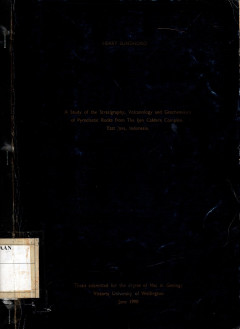
A Study of The Stratigraphy, Volcanology and Geochemistry of Pyroclastic Rock…
The Ijen caldera complex is located in an active tectonic region, where the Indian plate is now sliding approximately northward beneath Java at about 6-7 cm/yr. This study is in two parts, the firs is detailed field mapping and includes a geological map and stratigraphy, which form the basis for other work. The second concentrates on the post-caldera pyroclastic deposits.
- Edisi
- -
- ISBN/ISSN
- -
- Deskripsi Fisik
- 193 hal.; gbr.; lamp.; tabel.
- Judul Seri
- -
- No. Panggil
- PVG (043)551.7 SUN s c.1
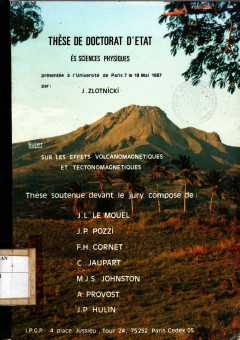
Sur Les Effets Volcanomagnetiques Et Tectonomagnetiques
Attire par magnetisme des Roches puis rapidement par les applications du magnetisme a la volcanologie et a la sesmogenese, j'ai trouve au fil des annes a L'IPGP puis, a l'exterieur, des cooperations scientifiques et techniques qui m'ont permis de developper mes travaux.
- Edisi
- -
- ISBN/ISSN
- -
- Deskripsi Fisik
- 373 hal.; gbr.; tabel.
- Judul Seri
- -
- No. Panggil
- PVG (043)551.21 ZLO s c.1
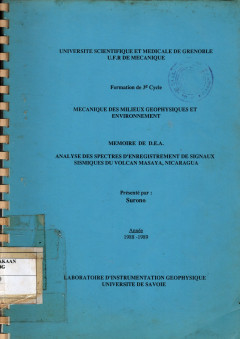
Analyse Des Spectres D'Enetgistrement De Signaux Sismiques Du Vucan Masaya, N…
L'observation des signaux sismiques d'origine volcanique est une methode importante d'etude de l'activite des volcans.
- Edisi
- -
- ISBN/ISSN
- -
- Deskripsi Fisik
- 36 hal,; gbr.; lamp.; tabel.
- Judul Seri
- -
- No. Panggil
- PVG (043) SUR m c.1
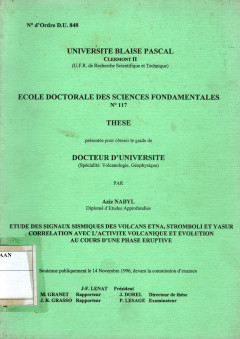
Etude des Signaux Sismiques des Volcans Etna, Stromboli et Yasur Correlation …
Les volcans, bien qu'ils soient des object d'investigations passionnants pour les volcanologues, demeurent avant tout des dangers pour les populations.
- Edisi
- -
- ISBN/ISSN
- -
- Deskripsi Fisik
- 191 hal,; gbr.; tabel.
- Judul Seri
- -
- No. Panggil
- PVG (043)551.21 NAB e c.1
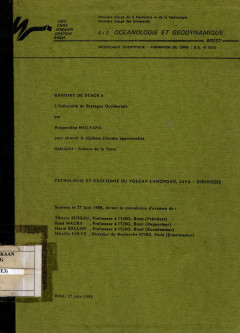
Petrologie et Geochimie Du Volcan Lamongan, Java-Indonesie
A I'heure actuelle, I'Indonesie possede 129 volcans en activite. Ces derniers se succendent depuis I'ile de Sumatra jusqu'aux Celebes et a la mer de Banda.
- Edisi
- -
- ISBN/ISSN
- -
- Deskripsi Fisik
- 78 hal.; gbr.; peta; tabel.
- Judul Seri
- -
- No. Panggil
- PVG (043)552(E2) MUL p c.1
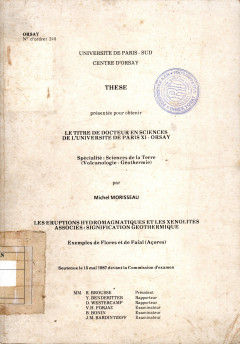
Les Eruptions Hydromagtiques Et Les Xenolites Ssoocies : Signification Geothe…
A study of the product of hydromagmatic activity and their associated xenoliths has been made on the recent volcanic centres on the island of Flores and Faila, in the Azores, in order to define the geothermal context.
- Edisi
- -
- ISBN/ISSN
- -
- Deskripsi Fisik
- 319 hal,; gbr.; lamp.; tabel; foto.
- Judul Seri
- -
- No. Panggil
- PVG (043)551.21 MOR I c.1

Volcanic Stratigraphy Geochemistry of The Idjen Caldera Complex,East Java Ind…
The Idjen caldera is classed as a Krakatoa type or stratocone caldera and is characterized by a caldera floor, a caldera escarpment, and older volcanic forms. The caldera diameter rangers from 14 by 16 km at the rim to 11 14 km at the floor with a maximum depth of 709m.
- Edisi
- -
- ISBN/ISSN
- -
- Deskripsi Fisik
- 144 hal,; gbr.; lamp.; tabel.
- Judul Seri
- -
- No. Panggil
- PVG (043)551.7(E3) SIT v c.1
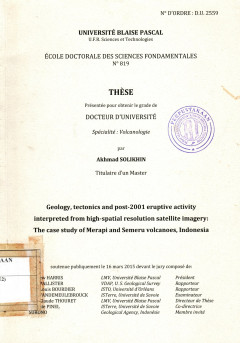
Geology,tectonics and post-2001 eruptive activity interpreted from high-spati…
Penginderaan jauh telah lama dikenal sebagau suatu alat untuk analisis di gunungapi aktif dan berbahaya karena dapat meningkatkan pemahaman kita tentang proses yang mendasari aktivitas gunung berapi sehingga memungkinkan kita untuk menerapkan pemahaman ini dalam pengurangan risiko erupsi gunungapi. Disertasi ini menyajikan studi vulkanologi menggunakan citra satelit optik resolusi tinggi (IKINO…
- Edisi
- -
- ISBN/ISSN
- -
- Deskripsi Fisik
- 229 hal,; gbr.; lamp.; tabel.
- Judul Seri
- -
- No. Panggil
- PVG (043)551.21(E2) SOL g c.1
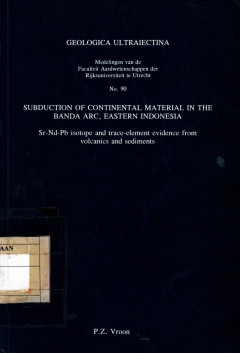
Subduction Of Continental Material In The Banda Arc, Eastern Indonesia : Sr-N…
This thesis presents the results of a geochemical study of the Banda Arc (East Indonesia) where magma genesis is influenced by subducted source components that are controlled by an active arc-continent collision. The main objective of this study is to investigate the role of subducted continental material on the magma genesis using isotopic and chemical compositions of samples from volcanoes an…
- Edisi
- -
- ISBN/ISSN
- -
- Deskripsi Fisik
- 205 hal,; gbr.; tabel.
- Judul Seri
- -
- No. Panggil
- PVG (043) VRO s c.2
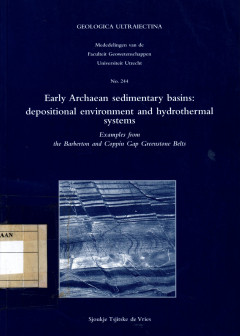
Early Archaean Sedimentary Basins : Depositional Environmemt And Hydrothermal…
Sedimentary basins are well studied topic in geology, much is known about the setting in which they form, and the different type of basing fills. Less is know about basin early on in Earth history, particularly in the early Archens.
- Edisi
- -
- ISBN/ISSN
- -
- Deskripsi Fisik
- 159 hal,; gbr.; lamp.; tabel.
- Judul Seri
- -
- No. Panggil
- PVG (043)551 VRI e c.1
 Karya Umum
Karya Umum  Filsafat
Filsafat  Agama
Agama  Ilmu-ilmu Sosial
Ilmu-ilmu Sosial  Bahasa
Bahasa  Ilmu-ilmu Murni
Ilmu-ilmu Murni  Ilmu-ilmu Terapan
Ilmu-ilmu Terapan  Kesenian, Hiburan, dan Olahraga
Kesenian, Hiburan, dan Olahraga  Kesusastraan
Kesusastraan  Geografi dan Sejarah
Geografi dan Sejarah